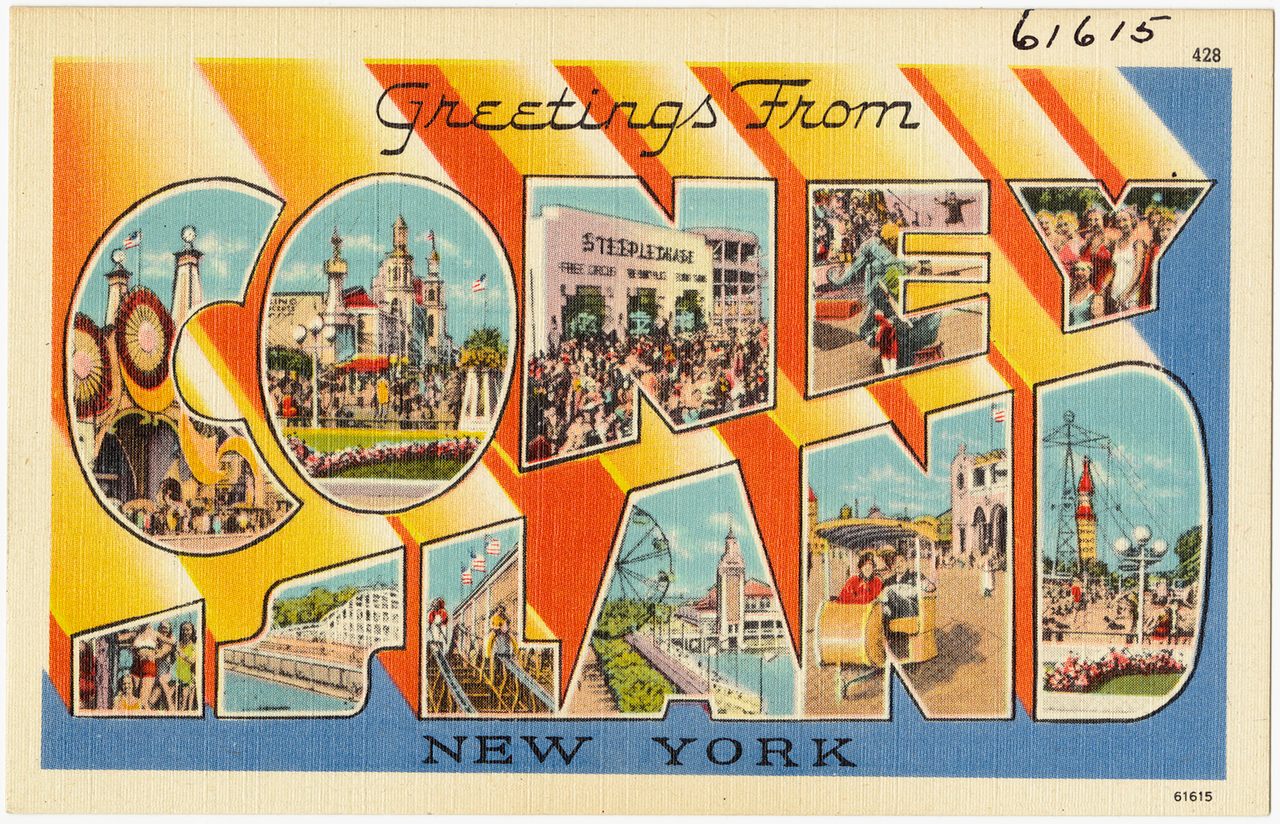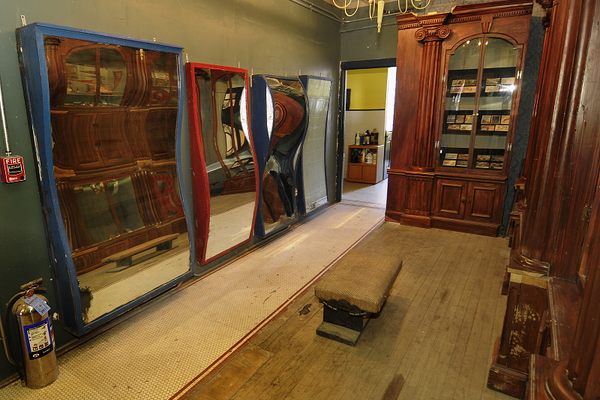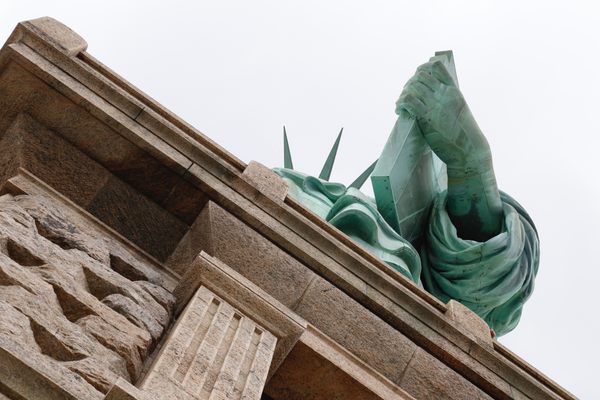Coney Island Was Once Full of Dueling, Backstabbing Theme Parks
Come one, come all to the controversial, ugly beginnings of what was once called ‘Sodom by the Sea.’
Coney Island was once a glittering star of the early 1900s. It was the Progressive Era, amusement parks were becoming enormously popular across America, and New York City’s version of roller coasters and carnival games seemed like the epitome of wholesome fun. But the beachy entertainment land was quite different than it is today. Coney Island mainly consisted of three theme parks: Steeplechase Park, Luna Park, and Dreamland. And from 1904 to 1911, all were locked into a perpetual dance of stealing acts, copying rides from each other, and some dirty competition.
This fleeting moment in time was captured by a little-known Brooklyn artist named John Mark. His rare 1906 “bird’s eye view” map was full of spectacular details at the three competing parks. Together, they helped turn around the reputation at Coney Island—which was once considered tawdry and called “Sodom by the Sea”—bringing clean fun to families.

“Coney Island was a laboratory for the invention and testing of social, commercial, and technological ideas,” says art historian Robin Jaffee Frank, who authored the book and curated the exhibition Coney Island: Visions of an American Dreamland. “Coney Island revolutionized the way people played.”
It all started with Steeplechase Park, which first opened in 1897. Founder George Tilyou was a popular figure in the area, and people knew his “Funny Place” was full of laughter. Guests rode his Ferris wheel and galloped around his celebrated Steeplechase horse ride. Amusing and frugal diversions were everywhere. Tilyou’s haunting cartoon visage, full of teeth and horned hair, became an icon still used today, known as “Funny Face.”

Tilyou often toured the country looking for ideas. At the 1901 Buffalo Pan-American Expo, he saw future Luna Park founders Fred Thompson and Skip Dundy and their popular “A Trip to the Moon” attraction. Designed by Thompson, guests boarded a futuristic Victorian spaceship and bumped their way to the colorful moon, where they walked among strange lunar creatures.
Tilyou was smitten. He lured them to Steeplechase in 1902 with promises of a significant share of profits—but it came with a risk. “Tilyou recognized that by securing ‘A Trip to the Moon’ for Steeplechase, he was inducing a future competitor to enter the field,” says historian Michael Immerso, author of Coney Island: The People’s Playground. The duo also brought their popular “Giant See-Saw” ride, which lifted people hundreds of feet in the air while seated in a rotating wheel at each end.
Much to Tilyou’s regret, Thompson and Dundy immediately started making plans for Luna. Prior to moving to the new park, they clashed over the seesaw. Tilyou wanted it. Thompson and Dundy wanted it—or money. Back and forth they went, like the seesaw. Dundy finally proposed an absurd bet. Tilyou could flip a nickel, and if he won, he could have it for free. If he lost, he would pay Thompson and Dundy $12,500 to keep it. Tilyou flipped and paid nothing.

Luna Park therefore opened in 1903 and made an immediate impression on the public. Luminous lights swirled around the park, punctuated by the brilliant Electric Tower easily seen across the island (which eventually became a peninsula using landfill). A boisterous spirit and fantastical architectural elements transported people. There were miniature trains and elephants. “A Trip to the Moon” kept the guests coming. Luna made Steeplechase look outdated by comparison.
“Luna Park served as a template for every amusement park that followed,” says Immerso. “Thompson was an exceptional choreographer. Every component of the park, visually and by sensory means, played a part in creating a singular and enchanting environment.” The partners were a perfect fit for each other. Thompson’s boyish spirit created the attractions, and Dundy was the financial whiz. But their partnership almost didn’t happen.
In fact, the two had already become well-acquainted with ride stealing, as that’s how the unlikely duo partnered up.

Leading up to the Buffalo expo—where Tilyou first saw them—Dundy had been impressed by an attraction that Thompson created for another fair. Dundy wasted no time and quickly scampered to Buffalo to shamelessly propose Thompson’s popular “Darkness and Dawn” as his own idea. Once Thompson realized his unpatented ride had been stolen, he tried to strike back with his own version. It became ugly. Fellow showmen started placing bets on who would get the coveted concession spot. The Brooklyn Daily Eagle reported, “Dundy knew a thing or two about the manipulation of sub-surface wires, and when the concession was awarded, he won in a walk.”
Rather than swear endless vengeance, Thompson couldn’t help but be impressed by Dundy’s audacious display. He had seen nothing like it before, so he magnanimously told Dundy about his gestating “A Trip to the Moon” idea and said they should work on it together instead, which they did. Although the Buffalo fair was a financial flop, their innovative experience was one of a few to make money, and it became a key part of Luna’s revenues for many years.
The parks were not beyond putting humans and animal suffering on display. During the construction of Luna, Thompson and Dundy acquired an elephant named Topsy but soon tired of her behavior and expense. For promotional purposes, they controversially electrocuted her in front of media members and a “moving picture” camera. The lurid newsreel still survives.

Villages of Indigenous peoples were a popular fixture at fairs across the country, put on display for European descendants to stare at. In 1905, Thompson and Dundy took note of a particular group of Indigenous people from the Philippines, which promoters called “Igorrotes,” but who were actually Bontoc people. The owners wanted the same act. Signed contract in hand, the “Igorrotes” became a star attraction at Luna. The owners and press spread the idea that spectators could watch them feasting on dogs in what was typically a staged act forced upon them. It was an “Imperialist fantasy on display,” which “enforced a racial interpretation of hierarchy, expansion, and exclusion,” according to the Coney Island Museum.
Yet Luna was considered an exemplary theme park of the time. Seeing its success, a man named William Reynolds saw dollar signs and wanted in. The slippery, former state senator was also a real estate magnate (who was later indicted for hiding his ownership in condemned property and stealing city funds). In 1904, he opened a competing theme park called Dreamland. It was a glowing white city by the sea that cost millions and targeted the genteel set. He wasn’t a born showman, so he ripped off as many attractions as he could and made them more grandiose.

Dreamland’s enormous electric tower was covered in 100,000 twinkling lights. They copied Luna’s Shoot the Chutes water flume ride, but added an extra track and planted the towers in the ocean. Luna had a disaster show called Fire and Flame, so Dreamland had their own version called Fighting Flames, which was more elaborate. The groundbreaking infant incubator display at Luna was replicated. Reynolds laughed at the meager ballrooms found at Steeplechase and Luna. His huge ballroom sat on his pier above the Atlantic Ocean.
Despite Dreamland’s opulence, Luna remained more popular. So Reynolds told his general manager to do whatever was necessary to drum up business. Operating in secrecy, Dreamland promised the Filipino community at Luna better working conditions and more money, and convinced them to leave the former park for the newer one. Thompson and Dundy were furious but tried to save face by absurdly claiming they closed the exhibit because they didn’t want to exploit the Bontoc people.

In 1907, the year after Mark’s map was created, Steeplechase was destroyed by fire, but Tilyou soon reopened. That same year, Dundy unexpectedly died and Thompson started a slow descent into bankruptcy. Dreamland was burnt to a crisp in 1911, and Reynolds never rebuilt. The golden era was over.
The theme parks of Coney Island continued to evolve over the next few decades, with Deno’s Wonder Wheel built in 1920 and the Cyclone roller coaster opening in 1927. Though the original Luna Park closed during World War II, an unrelated Luna Park opened in a different location on Coney Island in 2010, where it’s in operation today. Few remnants of the original three parks survive, but replicas of Tilyou’s iconic “Funny Face” can still be seen here and there. Both the Coney Island History Project and the Coney Island Museum have artifacts from previous eras on display.
As for the map, it is only known to have appeared in two small classified ads in a local newspaper. In one, the artist offered his Coney Island “Souvenir bird’s eye view” map for a dime and suggested people could “Mail It to Your Friends.” The other asked for the “greatest seller” to peddle his maps for “100 per cent. profit.” Afterwards, the artist faded from view and the map became lost to time, yet remains on record as a snapshot of Coney Island’s foundational, backstabbing theme parks.
























Follow us on Twitter to get the latest on the world's hidden wonders.
Like us on Facebook to get the latest on the world's hidden wonders.
Follow us on Twitter Like us on Facebook